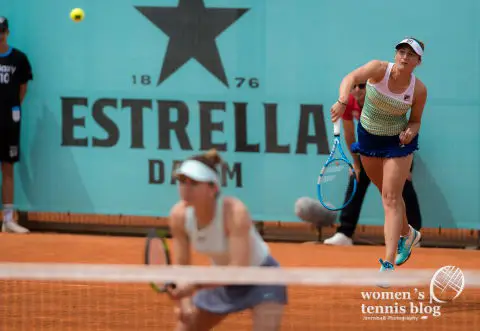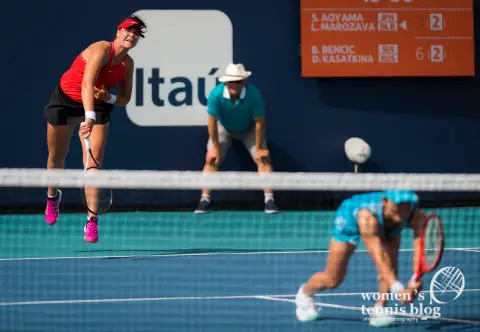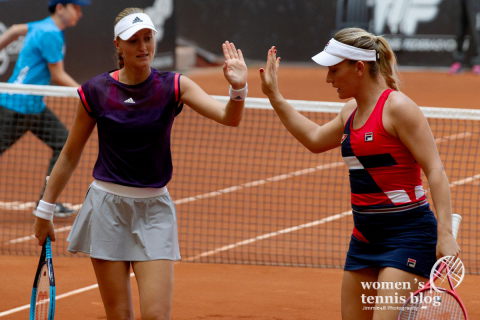This is a guest post by our monthly contributor, Will Boucek, a former college tennis player from Austin, with over 20 years of experience playing and coaching. Will specializes in doubles and was 4.5 men’s and mixed doubles champion in Texas in 2017. Fascinated by the strategy of doubles, Will shares his valuable insights on his website The Tennis Tribe. In this month’s column, Will is guiding doubles players to make the best of their serves and improve their stats in that department.

Holding serve in doubles tennis is even more important than it is in singles, because it’s so difficult to break.
In singles, you can chip a weak return back to get the point started. Not in doubles… There’s a second player on the other side of the net that will make you pay. You simply cannot get away with a weak return in doubles.
Since holding serve is so important, today I want to show you a few serve strategies that you can use to hold serve more easily.
The server’s advantage in doubles
The real advantage that the serving team has in doubles (and singles) is in the first several shots of the rally. After the fourth or fifth shot, it’s like you’re playing a point off the ground. So we need to focus on those first few shots to create our advantage. There are three primary ways we can do this:
- Ace the opponent;
- Force missed returns;
- Set up your net player.
The first one is simple enough. Go work on your serve and hit your spots. The next two, though, is where many doubles players could see big improvements, without having to practice 1,000 serves per week.
Hint: It’s often the net player that needs to change what they’re doing, not the server.
How to force missed returns
Missed returns can be caused by two things:
- A really good serve;
- A smart net player.
Most often in doubles, missed returns are caused by a combination of the two.
Practicing your serve is one of the most important things you can do for your doubles game. Hitting a high percentage of first serves, into the corners with some body serves mixed in, will make you a great player at any level.

How can you make your serve even better in doubles?
Get a smart partner at the net.
A good net player is always changing the window the returner must hit into. Sometimes they will give them a narrow crosscourt window and a big window down the alley. The next point, they may close the window down the line as the serve crosses the net, forcing the returner to change direction.
Smart net players will poach, pinch, and fake. They move laterally, not just forward and backwards. All this movement forces the opponent to hit into smaller windows, closing windows, and different directions every time. This makes the returner’s life difficult and results in a lot of missed returns.
Since we’re trained to not hit at the net player, an active net player can be a server’s best friend in doubles.
Pro Tip: Mix in the I-formation & Australian formation to really throw your opponent off.
Set up the net player
Setting up the net player is another way to get easy points on your serve in doubles. It’s all about being aware of a few things as a server:
- The opponent’s strengths and weaknesses;
- The angles of the court;
- Your strongest and weakest serves.
Observe your opponents
During the first few games, you need to be analyzing your opponents:
- Is their forehand or backhand better?
- Do they like pace or slower shots?
- Do they hit crosscourt or down the line better?
Maybe they can’t generate pace with their backhand, so a slow slice to the backhand is the best serve to choose.
Answering these questions will help you understand which serves will give you weak returns to set up your partner at the net. The ability to observe and exploit weaknesses is probably the best skill you can develop in doubles.

The angles of the court
As the serving team, you want to keep the ball in the middle of the court. That’s where most points are won in doubles.
Serving wide on the deuce side will give the returner angles to hit down the line with their forehand. It’s typically the worst serve choice in doubles. That said, if it’s one of your strongest serves and you can hit aces, go for it! Just don’t miss your spot 😉
Hitting up the T on the deuce side makes it more difficult for the opponent to hit down the line, so your partner can stay more aggressive.
The ad side is a little bit tricky. In short, you want to mix it up on this side a bit more.
Many coaches teach to serve the backhand, but again, this opens up the down-the-line pass for opponents. However, since most players only have a good crosscourt backhand, it might be a good strategy to bait them into that low percentage shot.
You can hit the wide serve and have your partner poach a few crosscourt shots, then fake and watch the opponent try to go down the line.
If you’re comfortable with your T serve here, try it on the first serve, but make sure you hit your spots. An accurate serve, closer to the line is better than a faster server that is less accurate.
If you can hit a body backhand serve on the ad side with depth, then you’ll create a lot of missed returns as well. Depth is a key to good serving, especially second serves, that many players don’t practice or focus on.
Summary
After reading lessons like these, a lot of people go out and try to mindlessly follow what I just wrote. Please do try it. if it works, keep it up. If not, change something!
Serving strategy, just like all doubles strategy, is about weighing the odds, strengths, and weaknesses of all four players on the court. Some of the strategies from above would fail miserably against a player who loves their down-the-line backhand, or is left-handed.
The strategies above work against most traditional teams. However, think for yourself, and change up the direction, spin, and pace of your serves to see what works best for each match.
MORE DOUBLES TIPS FROM WILL BOUCEK:
- The easiest way to improve your in-match doubles tennis strategy
- How to finally beat the lobber
- 3 ways to make your opponent miss in doubles





Great advice for all us 3.5 USTA league hackers! Thanks Marija, for posting this useful information. And thanks Will for the material. I will certainly pass it on to my partner, and we will try to execute it up here in the Dallas-Ft. Worth area of Texas!
Jim, I’m glad we’re helpful! I really appreciate Will’s contributions here. He covers useful topics I’ve never covered before. I’m sure all doubles players will benefit a lot from his tips.
1-I’m 4.0 , partner is 3.0 with a slow floating serve ….frustrated what do I do?
2-After my partner serves , opponent on deuce side gets up to net playing very offensively , I do not know what to do